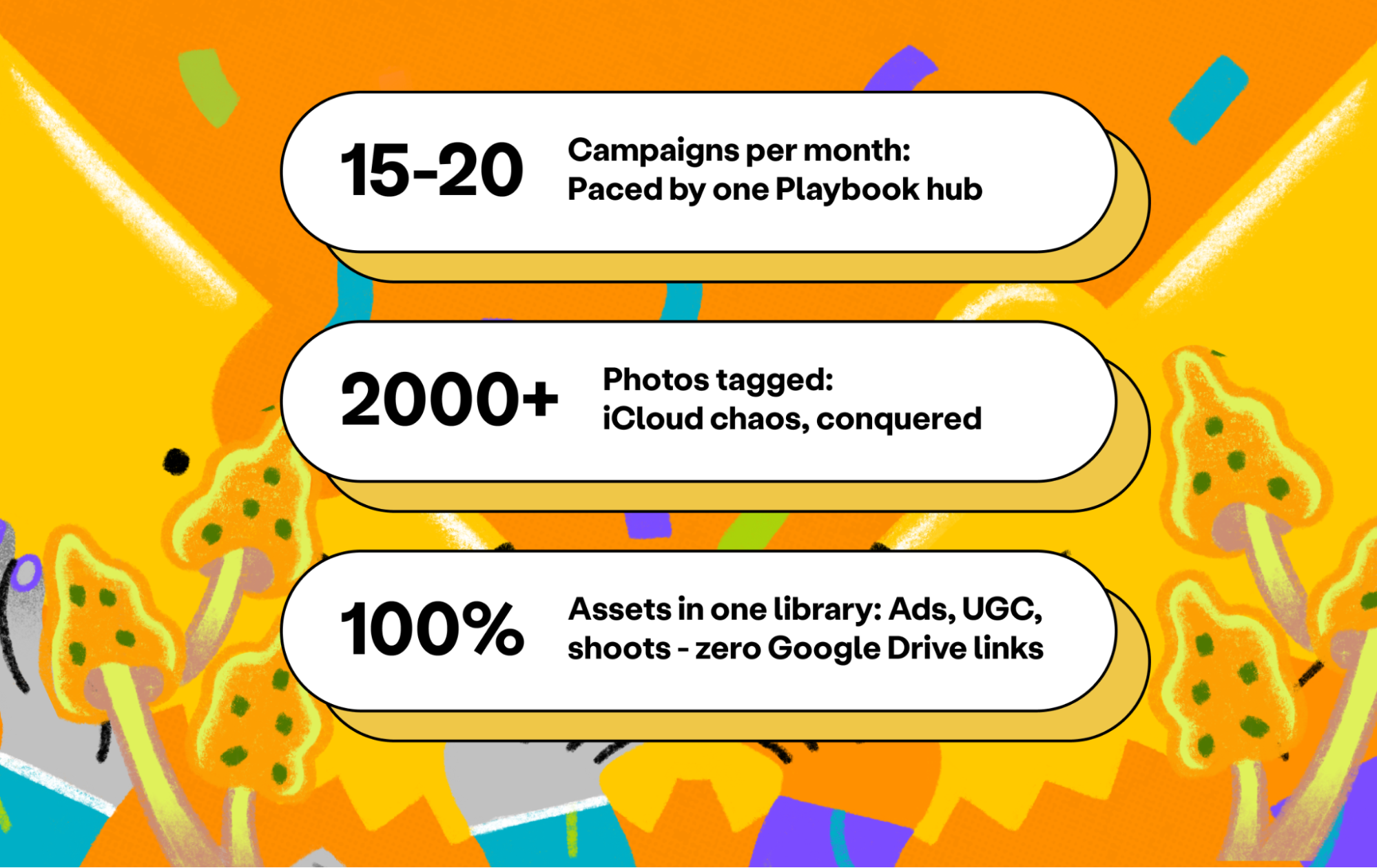Meet SuperMush and Silas
When Silas Bush stepped in as the fractional VP of Growth at SuperMush, he found himself at the helm of a wildly energetic Gen Z lifestyle brand, SuperMush - the 60s and 70s-inspired functional mushroom supplements brand that offers sex, sleep, and energy-boosting gummies.
When you’re launching 20+ creative campaigns a month across TikTok, email, paid ads, and affiliate partners, things can get real messy. Still, behind the scenes, marketing ops were tangled in disjointed tools and folders, making it a nightmare to work with.
“We were absolutely a creative-first kind of brand,” said Silas Bush, fractional VP of Growth at the time.
However, all their creative assets were scattered across iCloud libraries, comprising over 2,000 images, a maze of Google Drive folders, PowerPoint presentations, and random direct messages.
With no single source of truth, finding the correct file at the right time was nearly impossible, let alone launching fast-moving campaigns.
So, here’s how they cleaned it up. Silas made a bold move and decided to turn to Playbook to transform SuperMush’s fragmented ecosystem into an efficient, searchable, and scalable operation, without sacrificing the brand’s vibe.
Playbook resulted in faster campaign launches, fewer missed creative opportunities, and a team that can finally stop file hunting. By organizing their creative media in one place, SuperMush was able not only to fix their workflow but also to accelerate their growth.
With Playbook’s help, SuperMush was able to achieve:

Google folders, iCloud photos, and endless DMs
SuperMush’s core lineup—Energy, Passion, and Sleep gummies—is not only functional but also fun. From collabs with roller rinks to photoshoots at music festivals, the team’s marketing strategy relies on being everywhere, all the time.
That meant content. A lot of content.
“We ran 15 to 20 campaigns a month, and each campaign had at least four or five ads,” said Silas. “We wanted to scale horizontally, not just pick one ad and throw money at it.”
Creative came in from all angles: community UGC, internal shoots, affiliate partners, and fan submissions. But the brand lacked a shared source of truth.
The creative stack was completely decentralized:
- iCloud photo library for team content (yes, really)
- PowerPoint decks full of inspo ads and visual notes
- Campaign files, folders, and ad copy buried in Google Drive folders from 2022
- Random DMs and WhatsApp threads with user-submitted content
Even UGC, which SuperMush leaned on heavily, was unsearchable or buried, despite its high quality. “We had a shared iCloud Photos Library. I’ve never seen another client do that. It was wild.”

The breaking point: A packaging refresh gone wrong
The moment we knew we needed to fix this came during a product refresh.
SuperMush had updated its packaging—from tubes to resealable bags. It should have been a clear transition, but instead, it revealed just how broken their system was. Their ad library still had assets with the old look, and that became a problem fast.
“There were ads in motion with old product, and the founder was like, ‘I don’t want to use anything with the old product.’ Which meant… nothing got used. For a while.”
Silas and his team had to manually sort through years of content to find what matched the new branding.
There were no tags. No filters. No version control.
Without it, the team had to sort through 2,000+ assets to find anything remotely usable manually.
That was the moment they knew something needed to change. Campaigns couldn’t afford to be delayed by these processes any longer.
Playbook: The tool that finally matched their energy
Silas led the migration to Playbook, starting with a significant backlog project that required tagging everything from scratch and creating a new structure from the ground up.
The goal was simple: Turn creative chaos into clean, collaborative workflows.
And the timing was perfect. They were just gearing up for a big campaign where they were launching a new product bundle cheekily named Wet Dreams (a combo of the sleep and passion gummies).
“We ran that whole campaign through Playbook. Moodboards, shot lists, casting schedules… it was all in there.”
The team used Playbook to:
- Build a master folder system organized by product (Energy, Sleep, Passion) and campaign
- Use smart tagging for people, products, and file types (copy, video, UGC, etc.)
- Store copy, design, and video files in one place (finally)
- Set up public-facing boards for partners, creators, and freelancers
- Tag founder content and even identify key people in photos
Playbook didn’t just replace Google Drive or iCloud. It replaced the need for workarounds altogether.

Fast creative, faster launches
Playbook gave the SuperMush team something they hadn’t had in a while: breathing room. Suddenly, campaigns weren’t bottlenecked by missing files or unclear folders. Everything had a place, and everyone knew where to look. “We had all these great photos,” said Silas. “And no way to use them. Now? You just log in and see what’s there.”
The time savings showed up everywhere. Organic posts went live faster because the social team didn’t have to dig through the content. Ad launches felt smoother, with fewer back-and-forths or last-minute scrambles. Creative requests that used to take hours of searching became simple link shares. For new hires and collaborators, onboarding was a breeze. “If we were bringing on a new video editor,” Silas said, “I’d just say: ‘Here’s everything.’ That’s it.”
Not everyone on the team was going to learn the folder structure or tagging system, and that was fine. Silas built a shared “dump zone” inside Playbook, where teammates could upload raw content without worrying about where it would go. “I wasn’t going to teach the founders how to organize it,” he laughed. “So we built a master folder where you can dump photos, and then we'd organize it after. ”
The team finally had visibility into what content existed, what was live, and what needed work. “That sense of relief,” Silas said, “that we were actually using the creative content we had—that was the biggest benefit.”
SuperMush wasn’t the only one impressed.
Agency partners, creators, and even cofounders from other brands noticed the shift.
“Everyone really liked it. In CPG, people use the same tech stack. So when something actually good comes along, it gets attention.”
Silas even has an email thread with a cofounder comparing Playbook to other DAM tools—and singing its praises.

What’s next with Playbook
Today, SuperMush is still going strong—and continues to use Playbook.
Their latest rollout into Target stores is already live, and assets for that campaign are stored and shared through Playbook as well.
Even though Silas has since stepped back from day-to-day operations, he still sees boards being updated in real time.
“It’s cool that it’s still being used. Because it really works.”
SuperMush is proof that you don’t need a 50-person marketing team or a six-figure tech stack to streamline your creative process. You just need a place where your content can breathe—and your team can get to work.
“Let the people who use the tech choose the tech. If you shoehorn in the wrong tools, especially just because your investor likes it, you kill momentum before it starts.”

Does the creative chaos that Supermush experienced sound a little *too* familiar? Book a free Teams demo and see how Playbook helped Supermush go from scattered assets to 20+ campaigns a month, without breaking a sweat.
